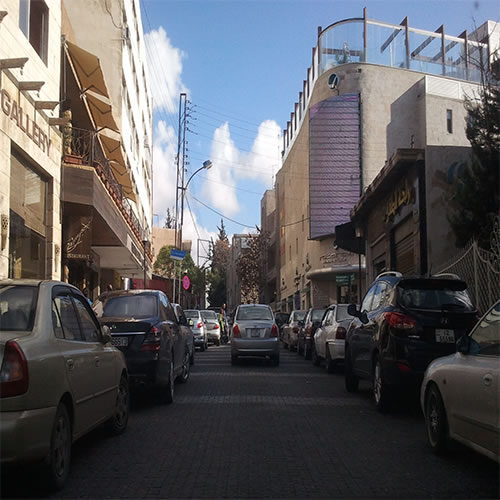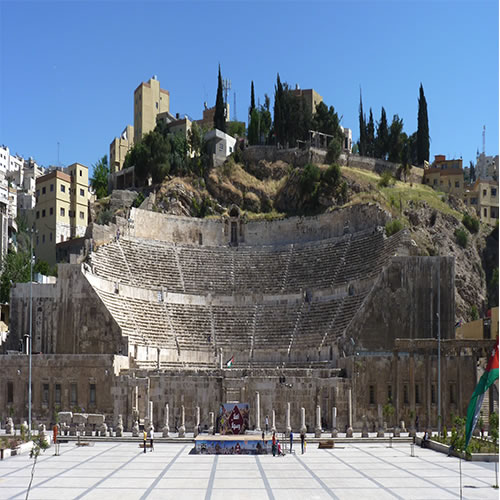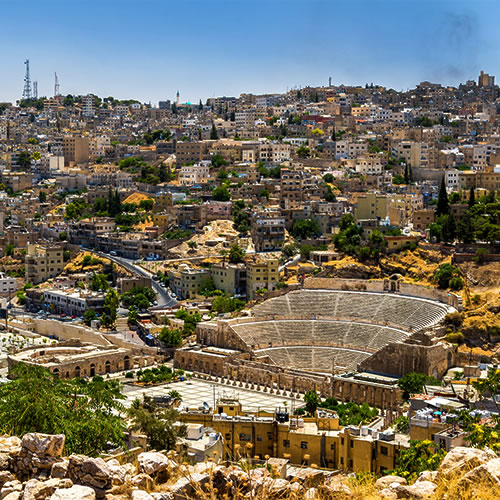Experience Amman

Overview
Amman, the capital city and the largest in Jordan, is filled with numerous ancient ruins and built on seven hills. This enchanting city offers a unique mixture of ancient and modern with its magnificent Roman Amphitheater ruins and the gleaming ultra-modern white buildings filling the city's commercial heart. Amman is nestled amongst the hills and valleys between the arid desert and the verdant fertile Jordan Valley. The neighborhoods and residents of Amman are diverse, this is also reflected in the cities the varied architecture, ancient roots, colorful souks, Roman ruins, museums, and monuments that paint a picture of the past.
Amman is a fascinating city, one of its greatest charms is in the hospitality of its people, where visitors are greeted with genuine warmth and smiling faces. It is a great base for exploring the rest of the country with great weather to boast. The city is brimming with vibrant art galleries, chic cafes, luxury hotels, charming boutiques, and delicious authentic Arabic cuisine. The city holds many surprises for its visitors get some retail therapy in at the modern shopping malls, visit fascinating museums, check out the many ancient ruins, there are many things to see and do.





Things to See and Do
Wander down the vibrant, bustling Rainbow Street one of the oldest streets in Amman. Set in the historic heart of Jabal Amman, this charming street is in a lively area lined with quaint shops, cute cafes, al fresco restaurants, quirky bars, and a few art galleries that are all worth exploring. There is a popular vibrant open-air market aka ‘Souk’ held in the area on Fridays filled with handicrafts, souvenirs, clothing, and fresh delicious foods. As the sun goes down this area comes alive and offers a variety of fun things to do.
Take time to marvel at the magnificent Jordan Museum, which presents the history and cultural heritage of Jordan through a series of beautiful and informative displays. It contains some of the most valuable archeological findings in the whole country in a series of beautifully designed galleries. Some highlights of the museum include the Dead Sea Scrolls, Neolithic limestone statues of `Ain Ghazal` (the oldest known human statue, a 9500-year-old plaster mannequin), and a copy of the Mesha Stele.
Check out the Jordan National Gallery of Fine Arts featuring a fascinating collection of temporary art from the 1970s to 2012 mainly from artists from Arabic areas. The museum consists of two buildings with three stories each set on an oval park featuring sculptures.
Visit the Amman Citadel which is undoubtedly one of the most important landmarks in the city with a deep history that dates back to the Middle Bronze Age (1550-1650BC). This ancient site sits atop Jabal al-Qala the highest of the original seven hills of Amman where visitors can encounter other remarkable landmarks such as the Temple of Hercules, the Umayyad Palace, and the Jordan Archaeological Museum, each one telling its own unique story. The Citadel overlooks the modern-day metropolis and provides some stunning views and dates back over 2,000 years to the Roman period.
Visit the awe-inspiring Roman Theatre nestled in the hillside of downtown Amman. The theatre was built during Antonius Pius the Roman Emperor`s reign (138-161 CE) and features 6,000 seats where musical performances are still held today. The Al-Balad Music Festival, The Amman International Book Fair, and the Amman Marathon are noteworthy festivals that are held here annually. The Jordan Folklore Museum and The Jordan Museum of Popular Tradition can also be visited on-site.
Marvel at the `Portico` featuring six columns standing 33 feet tall and the massive hand carved out of stone, identified as <'Hercules`s Hand', measuring 39 feet tall with the remains of three fingers and an elbow. The area is a great place to watch the sunrise or sunset and capture some breathtaking photographs with stunning views of the city and the ancient Roman Amphitheatre below.
The Children`s Museum Jordan is a brilliant place to visit with the kids, this hands-on museum is designed just for them, featuring 150 different interactive indoor and outdoor exhibits. There is an art studio, a library, an outdoor theatre, a restaurant, and a gift shop on site.
Visit the spectacular King Abdullah Mosque, this distinctive landmark in the city stands out with its magnificent blue mosaic dome. The mosque can house up to 7,000 worshippers with additional space for 3,000 more in the courtyard.


Shopping
Shopping in Amman offers visitors a few options with luxury shopping malls featuring a variety of stores and dining options. The Taj Mall is a high-end mall in Abdoun that features luxury brands and a cinema. The Mecca Mall boasts international brands as well as traditional shops, a bowling alley, and a children's play center. Abdali Boulevard is another high-end shopping center that boasts couture fashion with a unique European feel. Rainbow Street winds its way down from the 1st Circle and has a European feel to it. The quaint cobblestone streets here are populated with small antique shops, clothing stores, souvenir shops, cafes, and tea shops. The city has several craft centers offering unique handmade items such as mosaics and antiques, check out the Darat Mosaic and Ceramic showroom on Nicolas Ghanmah Street.
Amman is home to many unique ‘Souks’ like the Spice Souk, Gold Souk, and the Souk Jara that are brimming with many unique items including handicrafts, antiques, haberdashery, traditional textiles, lanterns, Gold and Silver jewelry, spices, herbal remedies, handmade soups and other trinkets. Other markets in this city sell items unique to the area such as Dead Sea Products, antique teapots, olive wood carvings, or a ‘keffiyeh’ which is a traditional checkered headpiece for Jordanian men. Abdali Market is a large open-air market that opens on Thursday evenings until Friday afternoons and is brimming with hundreds of colorful stalls selling anything and everything. The Jabal Amman summer street market is open on Fridays with stalls selling local wares, pop-up cafes, street food, and live performances that can be enjoyed here.


Cuisine
Arabic cuisine consists of a few basic groups which include meat dishes featuring lamb, chicken, or beef, never pork. A popular local tasty dish is `Shwarma` which is cooked lamb in a special sauce that is rolled in a piece of flatbread along with falafel, hummus and ful, cucumbers and tomatoes and the zingy tzatziki sauce. The food in Amman offers a lot of diversity due to its strategic position at the crossroads between the Mediterranean, the Middle East, and North Africa, and positioned with the Levant. Generally, Arabic food consists of several general basic groups. The city not only offers local authentic Arabic restaurants, traditional Middle Eastern eateries, familiar Western-style eateries, Asian fusion, French bistros, and Italian restaurants.
Meat dishes with lamb, or chicken, beef is a rare option, and pork is never offered. Shwarmas. Rice and flatbread are typical sides for most meals. Chick pea-based foods are very popular such as falafel, hummus, and fuul. Baklava is a popular sweet dish, as well as knafeh nabelseyyeh, a cheese pastry and syrup dish which originates from the Palestinian city of Nables. The city is brimming with coffee shops on every corner selling delicious fresh hot Turkish coffee and fresh pastries.
Hashem restaurant is a local treasure, it is one of the oldest restaurants in the country, famous for its Hummus and Falafel. It is located in the heart of the city and has maintained its high standards for decades. The restaurant is popular with the Royal Family with photographs of them dining at this restaurant displayed on the wall.
`Beit Sitti` (meaning my Grandmother`s house) is a restaurant that offers diners a unique dining experience set in the oldest neighborhood in the city. This popular restaurant and cooking school was established by three sisters who wished to keep their grandmother`s legacy alive through her recipes. The restaurant allows you to learn how to cook several Arabic dishes and then enjoy the fruits of your labor. (Reservations need to be made in advance.)


Nightlife
Nightlife in Amman is vibrant and eclectic with a busy downtown area where travelers will find many happening bars, restaurants, and hookah shops or shisha lounges. The Balad area is the old heart of the city boasting winding narrow alleyways and a maze of streets that lead to hidden treasures, that have plenty to offer those looking for a good night on the town. The colorful Rainbow Street comes alive at night and is lined with cafes and bars, live music can be enjoyed in a great authentic atmosphere. The Roman Theatre downtown offers many live concerts during the summertime in the amazing historic open-air theatre. The majority of the city’s popular pubs and nightclubs are found in the West Amman area and downtown. One of the main places people tend to spend their evenings in Amman is in the hookah shops.
It is highly advisable to see an Amman sunset from the viewpoint located near the famous Citadel, high on the hilltop with views over the city below. Also your attention to the time of the muezzin call. If you listen to it from the viewpoint, where the whole city lies before you, you get an unforgettable acoustic impression.
The national beer in Jordan is aptly called ‘Petra’ beer, Philadelphia, and Amstel beers are also brewed here. The country also produces some nice wines with the main two labels being Mount Nebo and Haddad. Araq is the Levantine cousin of Ouzo, Raki, and Pastis a popular alcoholic drink usually mixed with water and ice and accompanied by some mezzes or snacks.